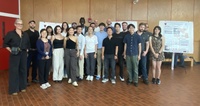Citation:
Abstract:
An ensemble of in vitro cardiac tissue models has been developed over the past several decades to aid our understanding of complex cardiovascular disorders using a reductionist approach. These approaches often rely on recapitulating single or multiple clinically relevant end points in a dish indicative of the cardiac pathophysiology. The possibility to generate disease-relevant and patient-specific human induced pluripotent stem cells has further leveraged the utility of the cardiac models as screening tools at a large scale. To elucidate biological mechanisms in the cardiac models, it is critical to integrate physiological cues in form of biochemical, biophysical, and electromechanical stimuli to achieve desired tissue-like maturity for a robust phenotyping. Here, we review the latest advances in the directed stem cell differentiation approaches to derive a wide gamut of cardiovascular cell types, to allow customization in cardiac model systems, and to study diseased states in multiple cell types. We also highlight the recent progress in the development of several cardiovascular models, such as cardiac organoids, microtissues, engineered heart tissues, and microphysiological systems. We further expand our discussion on defining the context of use for the selection of currently available cardiac tissue models. Last, we discuss the limitations and challenges with the current state-of-the-art cardiac models and highlight future directions.

